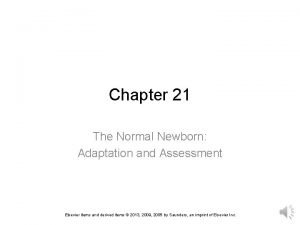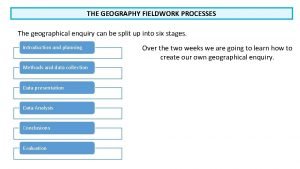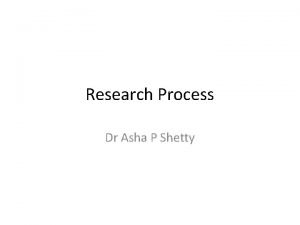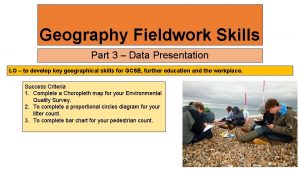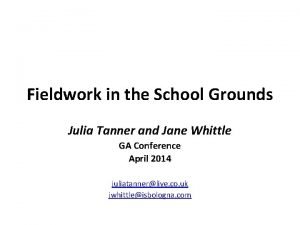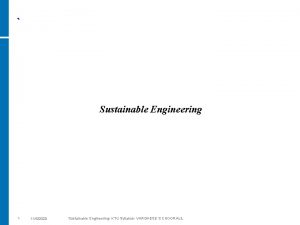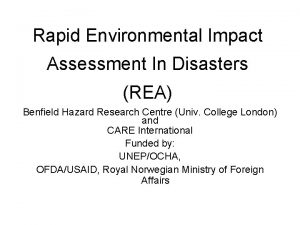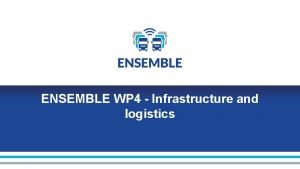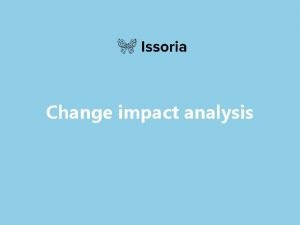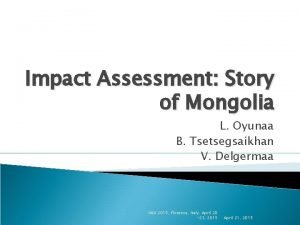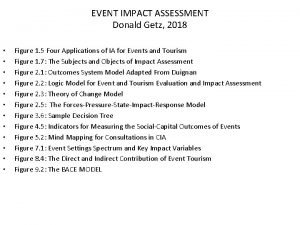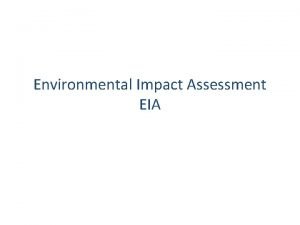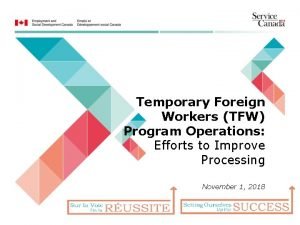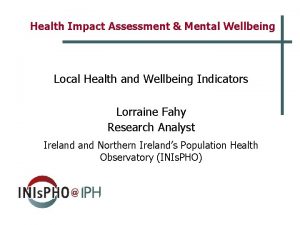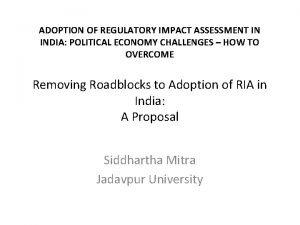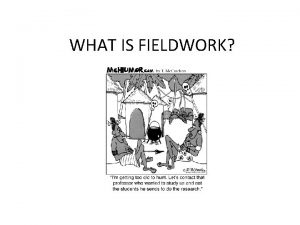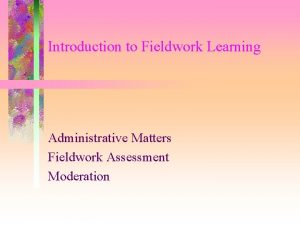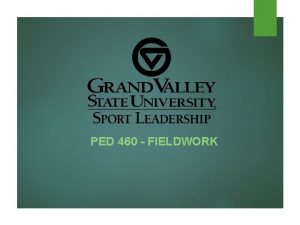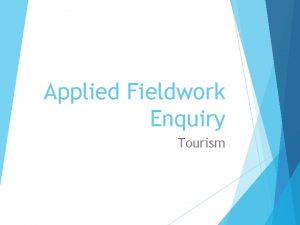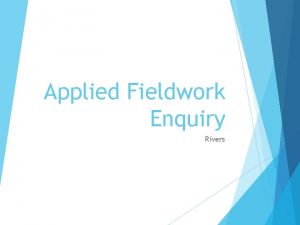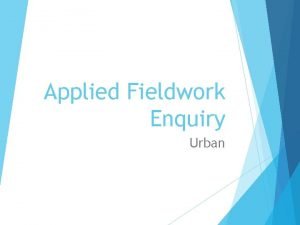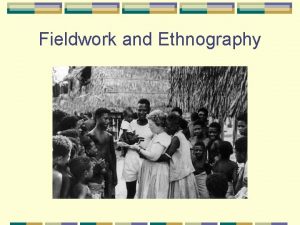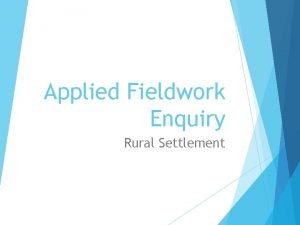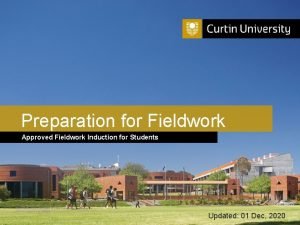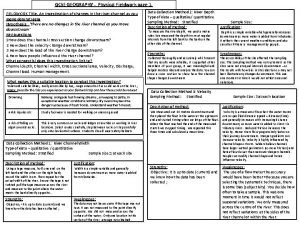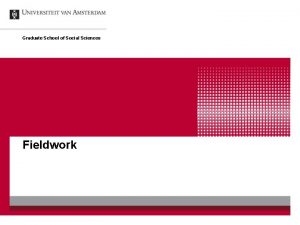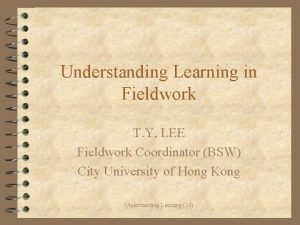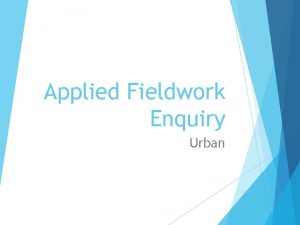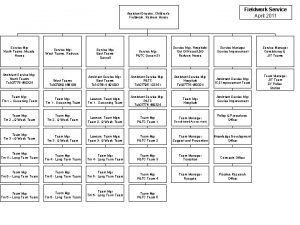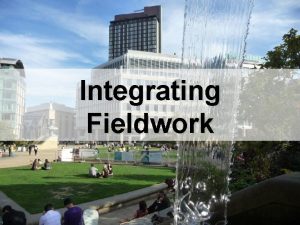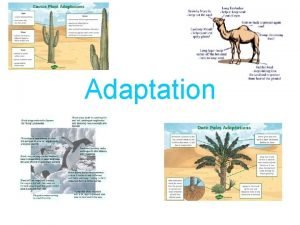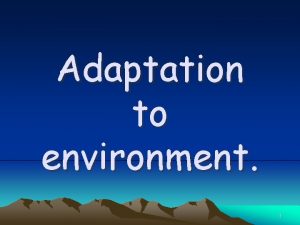CommunityScale Adaptation Assessment Fieldwork methods for project impact





















- Slides: 21

Community-Scale Adaptation Assessment: Fieldwork methods for project impact assessment AIACC_AF 14 Project: Lessons for Climate Change Adaptation in Northern, Eastern and Sahelian Africa

Overview Project background Fieldwork goals and approach Fieldwork methods Scoping: initial site visit Data collection: second site visit Validation: third site visit

Project background (1): Premise and Motivation Urgent adaptation needs of most vulnerable groups Increase current coping capacity through adaptation DCs in need of SD-consistent adaptation strategies Existence of local coping/adaptive strategies and lessons from other disciplines (e. g. , SL, disaster mitigation, natural resource management); potential for integration Many no-regrets options and co-benefits But, disconnect between community needs and policy process; dominance of technical/structural response

Project background (2): Goal To support the process of climate change adaptation to effectively respond to the needs of vulnerable communities by documenting cases of effective community resilience-building and sharing lessons on why these cases were effective and how to support similar activity.

Project background (3): Research Scope l l 3 or 4 case studies of successful SL projects in drought-prone communities Project impact assessment (fieldwork): – l Has the project succeeded in building community resilience? In what ways? To what effect? Policy process analysis: – What enabling factors account for project success? What policies, conditions, etc. (micro, meso, macro-scale) are behind successful experiences? How can these be built upon/encouraged?

Project background (4): Steps 1. Background/Preparation 2. Project Impact Assessment (fieldwork) Initial site visit (scoping) Second site visit (data collection) Third site visit (validation) 3. Policy Process Analysis 4. Synthesis

Project Impact Assessment: Goals Measure/describe impact of successful SL projects (change in community resilience preand post-project) In order to: Generate lessons for pro-poor adaptation policy, planning and implementation

Project Impact Assessment: Objectives Gain community trust, commitment and participation in the case study Confirm success of SL project Develop/finalize indicators Finalize and carry out data collection strategy Fill data gaps and validate findings Initiate policy process analysis

Project Impact Assessment: Approach Rely on community participation and expert judgment Develop locally relevant indicators and indicator criteria Blend quantitative and qualitative indicators using adapted version of the Livelihood Asset Status Tracking System (Bond and Mukherjee, 2002) Develop ‘word pictures’ with associated scores to measure changes in resilience

Initial site visit (scoping) PURPOSE: 1. garner community trust, interest in, and support of the project and the approach 2. confirm the success of the SL activities from community perspective 3. scope and schedule fieldwork, including participatory framework 4. identify key stakeholders and local informants

Initial site visit (2): Preparation CSR’s should be prepared to discuss: 1. a particular, locally-relevant climate extreme (signal event) 2. a set of generic, expert derived qualitative indicators 3. a process, including selection criteria, through which the community can consider and revise these indicators

Initial site visit (3): sample criteria for indicators Cells contain locally relevant criteria reflecting the productivity, equity and sustainability dimensions of each of the five capital assets TABLE 1: The five capital assets Natural Physical Financial Human Social Soil fertility Irrigation infrastructure Income Employment Education and training Access to crop land Access to irrigation system Access to credit Individual/hous ehold rights Access to decisionmaking Land Water management Savings and investme nt Health Local institutions Productivity Equity Sustainability managem ent

Initial site visit (4): sample indicators Box 2: Quantitative/Qualitative natural capital indicators: Land ownership/access (# ha) Food stores (# seasons) Fertility of land (soil quality) Location of land (degree of slope) Subsistence and cash crops (amounts of each; ratio) Fodder production (amount) Surplus seeds (ability to trade) Access to irrigation water (type and degree of access) Livestock holdings (# heads) Supplemental agricultural income (type; amount) Household food production (dairy? fruit? ) Access to forest produce (type and degree of access)

Fieldwork: Second site visit (data collection) PURPOSE: 1. familiarize community with data collection strategy 2. develop full sets of indicators (quantitative and qualitative) 3. assemble indicator-based assessment sheets for use in interviews 4. carry out interviews and assemble ‘word pictures’

Second site visit (2): Sample assessment sheet Table 2: Word pictures of household access/ownership of natural resources (assessment sheet) Adapted from Bond and Mukherjee (2002) Worst case 5 10 15 2 40 -60 60 -80 Best case 0 Land ownership/access little or no land Food stores one or two month's food available from own land Fertility of land red soil with low fertility more of black fertile soil Location of land is located on slope; rain water washes away seeds and top soil fertile land with moisture retention capacity Subsistence and cash crops use of traditional seeds grows and sells cash crops; grows vegetables; availability of home grown food throughout year; grows high yielding variety seeds Fodder production no land for growing fodder Access to irrigation water 20 -40 4 Indicator Surplus seeds 20 3 80 85 90 95 100 X hectares land lends seeds to others no source of irrigation facilities available round the year

Second site visit (3): Collecting data through WPs Approach to survey/interviews: Use household circumstances during signal event as basis of comparison; compare with circumstances during recent or hypothetical event Use assessment sheets (one for each capital) as basis of interview questions. For example: “During the signal event (e. g. , 1984 drought), what level of food stores did you have (in months)? Were they sufficient? If not, how great was the deficit (in months)? During the recent drought (post-SL activity) , what level of food stores did you have (in months)? Were they sufficient? If not, how great was the deficit (in months)? On assessment sheet, record number associated with interviewee responses to questions From these responses, assemble word pictures for each interview Record associated scores (for WPs pre- and post-SL activity) Keep interview to 15 -20 minutes

Second site visit (4): Resulting Word Pictures Hypothetical word picture of household’s access to natural resources (natural capital) Pre-SL Activity Post-SL Activity Little or no land; one or two month's food available from own land; quality of land is poor, having red soil with low fertility; land is located on a slope in such a position that rain water washes away the seed sown and the top soil and hence reduces its fertility; use of traditional seeds; some have given away land as collateral; no source of irrigation; no land for growing fodder for livestock; owns one or two livestock; no milk produced; low access to forest produce; More of black fertile soil; more land; grows one's own fodder on one's own land; fertile land with more moisture retention power; more produce from land; grows and sells cash crops; grows vegetables; grows high yielding variety seeds; lends seeds to others; irrigation facilities available round the year; land is near the forest; access to forest produce; some have government permit to grow opium; has many fruit trees; availability of home grown food throughout the year; many livestock, high returns from livestock; Adapted from Bond and Mukherjee (2002)

Fieldwork: Third site visit (validation) PURPOSE: 1. validate preliminary findings, using group meetings, targeted interviews and triangulation 2. Resolve TF and Project Team questions/concerns, conducting necessary follow-up inquiries 3. carry out inquiries for policy process analysis Note: Third site visit activities may be conducted as part of an extended second visit.

Third site visit (2): Preparation CSR’s should be prepared to discuss: preliminary findings of the survey process a process for resolving key questions a process for validating preliminary findings a process for conducting policy analysis inquiries

Fieldwork Synthesis l Outline data collected on changes in household and community resilience l Summarize changes in resilience to climate impacts following project intervention l Discuss the validation process l Discuss the role of the project intervention in building community resilience

 Elsevier
Elsevier What is geographical enquiry
What is geographical enquiry Undertaking clinical fieldwork
Undertaking clinical fieldwork Field work ap human geography
Field work ap human geography Fieldwork definition geography
Fieldwork definition geography Fieldwork sf
Fieldwork sf Data presentation geography
Data presentation geography Geography fieldwork in school grounds
Geography fieldwork in school grounds Direct and indirect wax pattern
Direct and indirect wax pattern Mcn 201 sustainable engineering syllabus
Mcn 201 sustainable engineering syllabus Hp
Hp Cipd self assessment
Cipd self assessment Rapid environmental impact assessment in disaster
Rapid environmental impact assessment in disaster Viscoroute
Viscoroute Change impact assessment template
Change impact assessment template Environmental impact assessment
Environmental impact assessment Event impact assessment
Event impact assessment Eia
Eia Labour market impact assessment lmia online web application
Labour market impact assessment lmia online web application Mental wellbeing impact assessment
Mental wellbeing impact assessment Mental wellbeing impact assessment
Mental wellbeing impact assessment Regulatory impact assessment india
Regulatory impact assessment india
